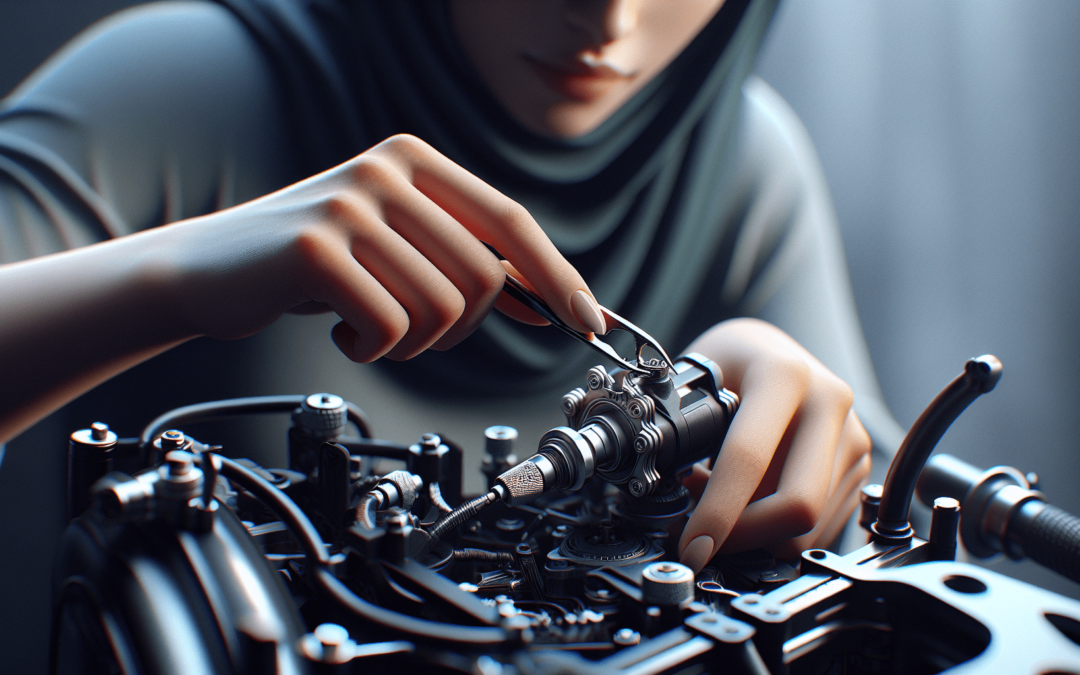If you’re struggling with a malfunctioning throttle on your Jetson Electric Bike, fear not! This article will provide you with simple and effective solutions to get your throttle back in perfect working condition. Whether it’s an unresponsive throttle or one that is stuck, we’ve got you covered. We’ll guide you through the troubleshooting process and provide step-by-step instructions on how to fix the throttle on your Jetson Electric Bike, ensuring that you can enjoy a smooth and hassle-free ride. Say goodbye to throttle woes and hello to an exciting biking experience!

Understanding the Throttle
What is the throttle?
The throttle is a crucial component of a Jetson electric bike that controls the speed and acceleration of the bike. It is typically located on the handlebar, allowing the rider to easily adjust the speed with a twist of the grip. Understanding how the throttle works and troubleshooting common issues can help ensure a smooth and enjoyable riding experience.
How does it work?
The throttle works by directly controlling the flow of electric current to the bike’s motor. When you twist the throttle grip, it sends a signal to the bike’s controller, which then adjusts the power output to the motor accordingly. The more you twist the throttle, the more power is delivered to the motor, resulting in increased speed.
Common throttle issues
Throttle issues can arise due to various reasons, such as wear and tear, loose connections, or electrical problems. Some common throttle issues include unresponsive or delayed acceleration, inconsistent speed control, or a loose or stuck throttle grip. Understanding these issues and knowing how to address them can greatly help in maintaining the functionality of your Jetson electric bike.
Checking the Battery
Is the battery fully charged?
One common cause of throttle issues is a low or depleted battery. Before diving into other troubleshooting steps, it is important to ensure that your bike’s battery is fully charged. Check the battery indicator on the bike’s display or use a battery voltage tester to verify the charge level.
Testing the voltage
To further confirm the battery’s condition, you can test its voltage using a multimeter. Set the multimeter to the DC voltage setting and connect the positive and negative probes to the corresponding terminals on the battery. A fully charged battery typically reads around 36-42 volts. If the voltage is significantly lower, it may be necessary to recharge or replace the battery.
Replacing or recharging the battery
If the battery voltage is too low or the battery fails to hold a charge, it may be necessary to replace it. Contact the manufacturer or a certified bike repair shop to ensure you get the correct replacement battery for your Jetson electric bike model. If the battery is simply discharged, follow the manufacturer’s instructions for recharging it properly.
Inspecting the Wiring
Checking for loose connections
Another potential cause of throttle issues is loose or disconnected wiring. Carefully inspect the wiring connections between the throttle, controller, and motor. Ensure that all connections are secure and tight. If you notice any loose connections, gently tighten them using a screwdriver or pliers.
Inspecting for damage or wear
Wiring can become damaged or worn over time due to exposure to the elements or general use. Look for any frayed or bare wires, as well as any signs of overheating or melting. If you identify any damaged wiring, it is important to replace the affected components to ensure proper functionality and safe operation of your Jetson electric bike.
Repairing or replacing faulty wiring
If you discover damaged wiring, it may be necessary to repair or replace the affected wires or connectors. For minor damage, you can use electrical tape or heat shrink tubing to insulate and secure the affected area. However, for more extensive damage, it is recommended to seek professional assistance or contact the manufacturer for replacement parts.
Cleaning the Throttle
Removing the throttle assembly
Regularly cleaning the throttle can help prevent debris buildup and ensure smooth operation. Start by disconnecting the throttle from the controller and gently removing the grip from the handlebar. Pay attention to any screws or fasteners that may be holding the throttle assembly together.
Cleaning the throttle grip
Once the throttle grip is detached, use a mild detergent or bike cleaner and a soft cloth or brush to clean the surface. Remove any dirt, grime, or sticky residue that may have accumulated over time. Avoid using harsh chemicals or abrasive materials that could damage the grip.
Cleaning the throttle body
To clean the throttle body, use a clean cloth or compressed air to remove any dust or debris. Be cautious not to oversaturate the throttle body with cleaning agents, as it may affect the internal electrical components. Gently wipe down the throttle body and allow it to dry before reassembling the throttle.

Calibrating the Throttle
Understanding throttle calibration
Throttle calibration is the process of ensuring that the bike’s controller accurately interprets the movement of the throttle grip. Calibration helps to establish the correct range and responsiveness of the throttle, ensuring smooth and consistent acceleration.
Accessing the calibration mode
Refer to the instruction manual provided by the manufacturer to determine the specific procedure for accessing the throttle calibration mode. This process may involve holding down specific buttons or switches for a certain period of time. Once in the calibration mode, follow the on-screen instructions or prompts to complete the calibration process.
Following the calibration process
During the calibration process, you may be required to perform specific actions with the throttle grip, such as twisting it to its full extent or releasing it to its resting position. Follow the instructions carefully and ensure that you complete each step accurately. Once the calibration process is complete, test the throttle to verify that it is functioning correctly.
Adjusting the Throttle Tension
Identifying throttle tension issues
Sometimes, the throttle grip may feel too loose or too stiff, making it uncomfortable or difficult to operate. Adjusting the throttle tension can help customize the grip to your preference, ensuring a comfortable and controlled riding experience.
Locating the throttle adjustment screw
The throttle adjustment screw is typically located on the underside of the throttle grip. It allows you to fine-tune the tension by tightening or loosening the screw. Look for a small screw or Allen key slot that is accessible when the throttle grip is removed.
Adjusting the tension to the desired level
To adjust the throttle tension, use a screwdriver or Allen key to turn the adjustment screw in either direction. Test the throttle grip after each adjustment to evaluate the tension. Continue adjusting the screw until you achieve the desired level of tension and comfort.
Replacing the Throttle
Identifying the correct replacement throttle
If your throttle is damaged beyond repair or you wish to upgrade to a different model, it is essential to identify the correct replacement throttle for your Jetson electric bike. Consult the manufacturer’s website, authorized dealers, or customer support to ensure compatibility with your specific bike model.
Removing the old throttle
To remove the old throttle, disconnect any wiring connections between the throttle and the controller. Loosen any screws or fasteners holding the throttle assembly in place. Gently slide off the old throttle grip from the handlebar, taking care not to damage any wiring or connectors.
Installing the new throttle
Install the new throttle grip onto the handlebar and secure it using the appropriate screws or fasteners. Reconnect the wiring connections between the throttle and the controller, ensuring proper alignment and secure connections. Test the new throttle to ensure it is functioning correctly.
Troubleshooting Additional Components
Checking the controller
If you have gone through the previous troubleshooting steps and are still experiencing issues with your throttle, it may be necessary to inspect the bike’s controller. Check for any visible damage, loose connections, or signs of overheating. If you suspect a faulty controller, it is recommended to seek professional assistance for repair or replacement.
Inspecting the motor
In some cases, throttle issues may be related to the bike’s motor. Look for any signs of damage, loose connections, or excessive wear on the motor. Ensure that the motor is securely mounted and that the wiring connections are tight. If you suspect motor-related problems, consult a certified repair shop or contact the manufacturer for further guidance.
Examining the battery charger
If you find your throttle issues persist even after checking the battery and wiring, it may be worth inspecting the battery charger. Ensure that the charger is properly plugged in and that the charging indicator lights up when connected to the bike’s battery. If the charger appears faulty or fails to charge the battery correctly, consider contacting the manufacturer or acquiring a replacement charger.
Seeking Professional Help
When to seek professional assistance
While many throttle issues can be addressed through troubleshooting and basic maintenance, there may be situations where seeking professional assistance is the best course of action. If you encounter complex electrical problems, extensive wiring damage, or if you are uncomfortable with performing repairs yourself, it is advisable to seek help from a certified repair shop or contact the manufacturer for assistance.
Finding a certified repair shop
To find a certified repair shop for your Jetson electric bike, consult the manufacturer’s website or contact their customer support. They can provide you with a list of authorized service centers in your area. Choosing a certified repair shop ensures that your bike is in capable hands and that any repairs or replacements are done using genuine parts.
Having the throttle professionally repaired
If you are unable to resolve throttle issues on your own or if the throttle requires professional attention, schedule an appointment with a certified repair shop. They will diagnose the problem, perform necessary repairs or replacements, and ensure that your throttle is restored to optimal functionality. This option gives you peace of mind and allows you to continue enjoying your Jetson electric bike without any operational concerns.
Preventing Throttle Issues
Regular maintenance
To prevent throttle issues and ensure the longevity of your Jetson electric bike, it is essential to perform regular maintenance. This includes cleaning the throttle, checking and tightening wiring connections, inspecting the battery, and performing any recommended manufacturer’s maintenance procedures. By incorporating regular maintenance into your routine, you can catch potential problems early and address them before they escalate.
Proper storage practices
When not in use, store your Jetson electric bike in a clean and dry environment. Excessive exposure to moisture, extreme temperatures, or direct sunlight can have detrimental effects on the throttle and other components. Invest in a bike cover or find a secure indoor storage space to protect your bike from the elements and maintain its optimal performance.
Avoiding excessive strain on the throttle
While it is tempting to go full throttle all the time, it is important to exercise caution and avoid putting excessive strain on the throttle. Sudden or continuous acceleration at high speeds can generate additional stress on the throttle and motor, potentially leading to premature wear or failure. Practice smooth and gradual acceleration to prolong the lifespan of your throttle and create a safer riding experience.
By understanding the throttle, performing regular maintenance, and taking appropriate measures to prevent issues, you can ensure that your Jetson electric bike continues to provide reliable and enjoyable rides. Remember to follow safety guidelines and always prioritize your well-being while riding. Happy cycling!


